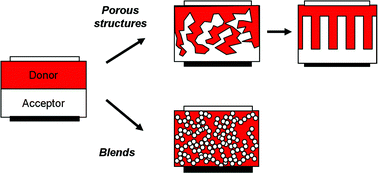We review progress in the development of organic–inorganic hybrid photovoltaic materials consisting of a conjugated polymer as an electron donor and a nanocrystalline metal oxide as the electron acceptor. We distinguish two main approaches: (1) where a rigid porous metal oxide structure is filled with polymer and (2) where metal oxide nanoparticles and polymer are co-deposited from solution to form a blend film. In the case of porous structures, performance is limited by the infiltration of polymer into the pores of the metal oxide and control of the nanostructure dimensions. In the case of blends, control of the blend morphology and transport between nanoparticles are limitations. In both cases, further improvements are possible by modifying the metal oxide organic interface to optimise charge transfer, by improving both inter- and intra-particle transport within the metal oxide phase, for example by the use of single crystalline nanorods, and by optimising the choice of electrode materials. Though unlikely to achieve the highest photocurrents, the polymer–metal oxide composites provide a model system to study the effects of interface properties and film morphology on the performance of bulk heterojunction photovoltaic devices.

You have access to this article
 Please wait while we load your content...
Something went wrong. Try again?
Please wait while we load your content...
Something went wrong. Try again?


 Please wait while we load your content...
Please wait while we load your content...